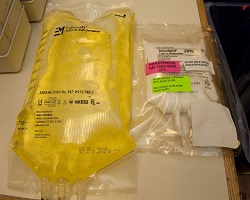Guidelines, Specifications & User Manuals
Link: Benefits and risks of parenteral nutrition in patients with cancer
Link:The Oley Foundation

Home Total Parenteral Nutrition (TPN)
This information will help teach you and your caregiver how to give total parenteral nutrition (TPN) at home.
About TPN
TPN is a mixture of nutrients put directly into your vein. Your mixture will contain whatever nutrients your body needs and may also include some medications. It’s used to help people who can’t get enough nutrients through eating alone.
You will get TPN through a central venous catheter (CVC). A CVC is a thin, flexible tube placed in a large vein near your collarbone. Your nurse will teach you about your CVC when you have it placed. Your TPN is given through your CVC during the night. This usually takes 10 to 12 hours.
What are the ways to properly administer TPN?
First, TPN is administered through a needle or catheter that is placed in a large vein that goes directly to the heart called a central venous catheter. Since the central venous catheter needs to remain in place to prevent further complications, TPN must be administered in a clean and sterile environment. For instance, external tubing should be changed everyday and dressings should be kept sterile with replacement every two days.
TPN is usually used for 10 to 12 hours a day, five to seven times a week. Most TPN patients administer the TPN infusion on a pump during the night for 12-14 hours so that they are free of administering pumps during the day. TPN can also be used in both the hospital or at home.
In fact, according to Children’s Hospital of Pittsburgh, approximately 40,000 people in the United States receive TPN at home. However, if TPN is given at home, it is crucial for patients to be given a qualified home nurse in order to better recognize various symptoms of an infection and be taught the correct steps of administering the nutrition. For example, patients must store their prescribed liquid in a refrigerator and remove each dose from the fridge about five minutes before use.
It is also important that the progress be followed and monitored by an interdisciplinary nutrition team. For instance, patients’ weight, CBC and electrolytes level should be monitored daily. In particular, plasma glucose should be monitored every 6 hours until patients and glucose levels become stable. Also, other measurements including liver function tests and full nutritional assessments including BMI calculation and Anthropometric measurements should be repeated at 2 weeks intervals.


